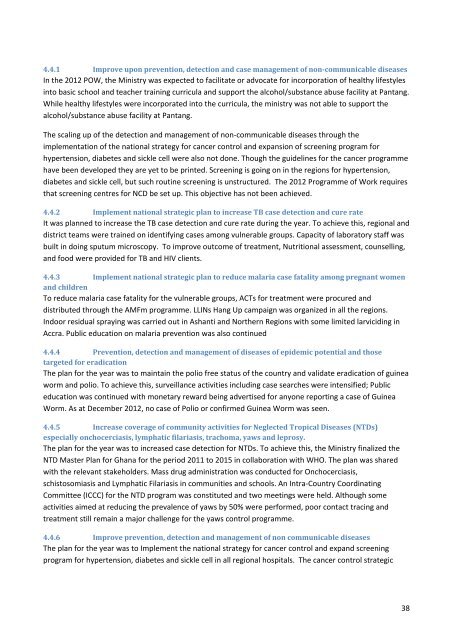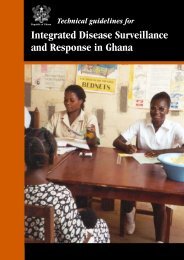2012 Holistic Assessment of Health Sector POW - Ministry of Health
2012 Holistic Assessment of Health Sector POW - Ministry of Health
2012 Holistic Assessment of Health Sector POW - Ministry of Health
Create successful ePaper yourself
Turn your PDF publications into a flip-book with our unique Google optimized e-Paper software.
4.4.1 Improve upon prevention, detection and case management <strong>of</strong> non-communicable diseases<br />
In the <strong>2012</strong> <strong>POW</strong>, the <strong>Ministry</strong> was expected to facilitate or advocate for incorporation <strong>of</strong> healthy lifestyles<br />
into basic school and teacher training curricula and support the alcohol/substance abuse facility at Pantang.<br />
While healthy lifestyles were incorporated into the curricula, the ministry was not able to support the<br />
alcohol/substance abuse facility at Pantang.<br />
The scaling up <strong>of</strong> the detection and management <strong>of</strong> non-communicable diseases through the<br />
implementation <strong>of</strong> the national strategy for cancer control and expansion <strong>of</strong> screening program for<br />
hypertension, diabetes and sickle cell were also not done. Though the guidelines for the cancer programme<br />
have been developed they are yet to be printed. Screening is going on in the regions for hypertension,<br />
diabetes and sickle cell, but such routine screening is unstructured. The <strong>2012</strong> Programme <strong>of</strong> Work requires<br />
that screening centres for NCD be set up. This objective has not been achieved.<br />
4.4.2 Implement national strategic plan to increase TB case detection and cure rate<br />
It was planned to increase the TB case detection and cure rate during the year. To achieve this, regional and<br />
district teams were trained on identifying cases among vulnerable groups. Capacity <strong>of</strong> laboratory staff was<br />
built in doing sputum microscopy. To improve outcome <strong>of</strong> treatment, Nutritional assessment, counselling,<br />
and food were provided for TB and HIV clients.<br />
4.4.3 Implement national strategic plan to reduce malaria case fatality among pregnant women<br />
and children<br />
To reduce malaria case fatality for the vulnerable groups, ACTs for treatment were procured and<br />
distributed through the AMFm programme. LLINs Hang Up campaign was organized in all the regions.<br />
Indoor residual spraying was carried out in Ashanti and Northern Regions with some limited larviciding in<br />
Accra. Public education on malaria prevention was also continued<br />
4.4.4 Prevention, detection and management <strong>of</strong> diseases <strong>of</strong> epidemic potential and those<br />
targeted for eradication<br />
The plan for the year was to maintain the polio free status <strong>of</strong> the country and validate eradication <strong>of</strong> guinea<br />
worm and polio. To achieve this, surveillance activities including case searches were intensified; Public<br />
education was continued with monetary reward being advertised for anyone reporting a case <strong>of</strong> Guinea<br />
Worm. As at December <strong>2012</strong>, no case <strong>of</strong> Polio or confirmed Guinea Worm was seen.<br />
4.4.5 Increase coverage <strong>of</strong> community activities for Neglected Tropical Diseases (NTDs)<br />
especially onchocerciasis, lymphatic filariasis, trachoma, yaws and leprosy.<br />
The plan for the year was to increased case detection for NTDs. To achieve this, the <strong>Ministry</strong> finalized the<br />
NTD Master Plan for Ghana for the period 2011 to 2015 in collaboration with WHO. The plan was shared<br />
with the relevant stakeholders. Mass drug administration was conducted for Onchocerciasis,<br />
schistosomiasis and Lymphatic Filariasis in communities and schools. An Intra-Country Coordinating<br />
Committee (ICCC) for the NTD program was constituted and two meetings were held. Although some<br />
activities aimed at reducing the prevalence <strong>of</strong> yaws by 50% were performed, poor contact tracing and<br />
treatment still remain a major challenge for the yaws control programme.<br />
4.4.6 Improve prevention, detection and management <strong>of</strong> non communicable diseases<br />
The plan for the year was to Implement the national strategy for cancer control and expand screening<br />
program for hypertension, diabetes and sickle cell in all regional hospitals. The cancer control strategic<br />
38















